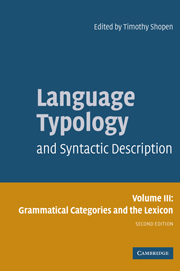Book contents
- Frontmatter
- Contents
- List of figures
- List of tables
- List of contributors
- Acknowledgements
- List of abbreviations and symbols
- 1 Typological distinctions in word-formation
- 2 Lexical typologies
- 3 Inflectional morphology
- 4 Gender and noun classes
- 5 Aspect, tense, mood
- 6 Lexical nominalization
- Bibliography
- Language index
- Subject index
- References
Bibliography
Published online by Cambridge University Press: 29 December 2009
- Frontmatter
- Contents
- List of figures
- List of tables
- List of contributors
- Acknowledgements
- List of abbreviations and symbols
- 1 Typological distinctions in word-formation
- 2 Lexical typologies
- 3 Inflectional morphology
- 4 Gender and noun classes
- 5 Aspect, tense, mood
- 6 Lexical nominalization
- Bibliography
- Language index
- Subject index
- References
- Type
- Chapter
- Information
- Language Typology and Syntactic Description , pp. 382 - 410Publisher: Cambridge University PressPrint publication year: 2007



